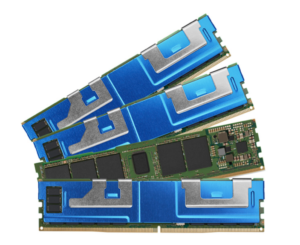
Intel Updates Optane, Expands NAND SSD Offerings

Intel Corp. remains persistent in upgrading its Optane persistent memory series. The chip maker (NASDAQ: INTC) said this week its second generation Optane series is tuned to the latest version of its Xeon Scalable processors (codenamed Cooper Lake), and boosts memory bandwidth by an average of 25 percent. The combination is aimed at four- and eight-socket servers supporting applications such as cloud data analytics.
The chip maker also announced a pair of new NAND drives built with Intel’s latest triple-level cell (TLC) 3D NAND technology and “an all-new low-latency PCIe controller to meet the intense IO requirements of AI and analytics workloads.”
Like the first Optane persistent memory solution, Optane 200 tops out at 4.5TB per socket in 6-channel configurations for a total of 18TB of memory in a four-socket server.
Demand for in-memory processing increasingly used in big data applications like interactive database queries have prompted Intel and other chip makers to boost memory bandwidth. When running analytics workloads such as the Spark-based cluster computing framework, Intel claims queries run eight times faster on Optane persistent memory than on DRAM-disk storage combinations.
The rise of application containers in datacenters also has boosted requirements for persistent memory. Hence, Intel emphasizes the advantages of larger persistent memory tiers, including increased CPU and server utilization and the faster delivery of distributed applications. The company also promotes Optane as a way to consolidate datacenter workloads since many virtual machines exhibit low CPU utilization.
Intel also cites widening gaps between memory and storage hierarchies as an emerging chokepoint in enterprise datacenters. That has forced operators to make tradeoffs between capacity, cost and performance. Increased memory bandwidth and augmenting traditional storage with persistent memory for stateful applications are driving architectures like Optane, it notes.
The new series “establishes new tiers in the memory and storage hierarchy, which provides the first opportunity for really truly persistent memory and volatile memory and persistent storage in multiple form factors,” said Lisa Spelman, general manager or Intel’s Xeon and Memory Group.
The company is targeting Optane at the increasing number of data analytics workloads overwhelming enterprise datacenters, touting persistent memory as accelerating data access. When compared to traditional NAND drives, Spelman claimed the latest version of Optane delivers more than 225 times faster CPU access to persistent data.
Meanwhile, higher memory bandwidth is intended to expand “the available memory pool to increase server utility,” Spelman added.
For example, Intel said in-memory databases equipped with next-generation Optane modules could provide access to more data at DRAM-like speeds. For science, data warehousing and analytics workloads, the updated architecture eliminates the need to load and store data locally.
With greater memory capacity per socket than DRAM, Intel also touts Optane as creating more capacity for virtualizing future workloads requiring more memory capacity. That, the chip maker said, would provide efficiencies when processing demanding workloads that would otherwise run on bare metal.
The latest version of Optane also operates in memory-only and “app direct” modes. In the former, a CPU memory controller accesses Optane as volatile rather than persistent system memory. In memory mode, DRAM is used as cache. The mode is promoted as allowing the deployment of more virtual machines, with more and cheaper memory per VM than DDR4 DIMMs.
Meanwhile, the app direct mode boosts memory capacity and data persistence, allowing application software to access DRAM and persistent memory in tiers, Intel said. The approach is touted as reducing latency while supporting larger data sets.
 The Series 200 version of Optane comes in 128-, 256- and 512-Gb modules that can be mounted on the same motherboard slots with DRAM. Intel said it is shipping the new series to customers now.
The Series 200 version of Optane comes in 128-, 256- and 512-Gb modules that can be mounted on the same motherboard slots with DRAM. Intel said it is shipping the new series to customers now.
Optane Series 200 product specifications are here.
In parallel with its Cooper Lake and FPGA rollouts, Intel also announced expansion of its 3D NAND portfolio with the availability of D7-P5500 and the D7-P5600 devices built on Intel’s floating-gate 3D NAND technology. Spelman said the new NAND SSDs are ready for both PCIe gen3 and gen4 environments, and deliver 40 percent lower latency and one-third better performance than the prior generation of NVMe NAND.


























